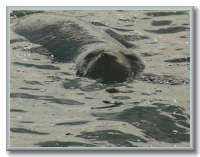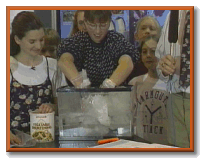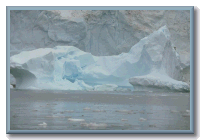PASSPORT TO ANTARCTICA (PTANT) builds on resources originally gathered to support a series of live, interactive "electronic field trips." These materials have now been completely re-edited and reformatted into an evergreen package of materials that can be implemented anytime during the school year, and anywhere there's a teacher dedicated to turning young minds on to the wonders of the natural world. (click here to preview the eight 15 minute PTANT videos) Watching the programs on videotape frees you from difficulties with live satellite downlinks, and the PTANT website (if you subscribe for all or some of the school year) allows you to time-shift interaction with Antarctic researchers to whenever it works best for you and your schedule.
|
|
The original projects benefited immensely from collaboration with NSF's Office of Polar Programs which manages for the nation all research undertaken as part of the "United States Antarctic Program" or USAP. OPP's support allowed PASSPORT TO KNOWLEDGE (P2K) to visit America's 3 main research sites (McMurdo, Amundsen-Scott South Pole Station and Palmer Station) as well as several extremely remote field sites. Spending many months on "The Ice", as old hands call this continent, P2K was able to accumulate an unparalleled video archive with which to document both the research and the lives of enthusiastic researchers in some of the most challenging and beautiful sites on Earth. Our sincere thanks to Guy Guthridge, Polly Penhale, Dave Bresnahan, Cornelius Sullivan, Dennis Peacock, Pat Smith and many others for making this possible. NASA also supported the original LIVE FROM ANTARCTICA projects with satellite resources and funding for educational materials. Thanks also, therefore, to the NASA Education Division, Code FE, the IITA CAN program, and to the ACTS satellite project.
But PASSPORT TO ANTARCTICA is far more than a set of TV programs, no matter how lively and informative. For students, the availability of the Hands-On Activities makes watching the videos just the beginning of the learning experience. Three Teacher's Guides are available in print, together with an Implementation Guide (IG). (For subscribers to the website, all hands-on Activities and student and teacher worksheets, together with the text of the IG, are accessible on-line as HTML or PDF documents.)
LIVE FROM ANTARCTICA offers 15 Activities. The LIVE FROM ANTARCTICA 2 Guide provides 33 more. NSF's POLAR CONNECTIONS suggests another 8, a total of 56 Hands-On Activities-far more than any teacher would ever want or have time to implement. The Implementation Guide selects specific Activities which P2K thinks best complement and enhance the videos. The videos themselves have been structured to embody key scientific principles likely to be found in most courses of instruction.
How to use the full set of PASSPORT TO ANTARCTICA resources PASSPORT TO ANTARCTICA is designed to be a powerful but easy-to-use package of materials and resources. It has been shaped by educational designers and multimedia producers working collaboratively with classroom teachers over several years. It provides more than enough information and activities to function as a 6-8 week replacement unit for segments of your current Earth and Life science curriculum. Or it can be used to supplement your existing texts with current and engaging experiences.

Here's how we hope the integrated multiple media materials will work: after seeing penguins and seals in their natural environment (programs 4 and 5), the Blubber Glove activity (LFA2 Guide, page 40) provides a chilly and literally hands-on activity through which students can experience how layers of fat insulate living flesh from icy waters. Extending this simple-to-implement but extremely memorable experience, students can go on-line and find out more about the creatures of the Antarctic and the researchers who study them. It's a 1-2-3 punch which utilizes the unique P2K learning model in which "100% video + 100% hands-on + 100% on-line" makes Real Science, Real Scientists and Real Locations into Real Learning. (See the chart which follows for a summary of some the most important scientific principles which each video and set of Activities will help you cover.)

![]()
